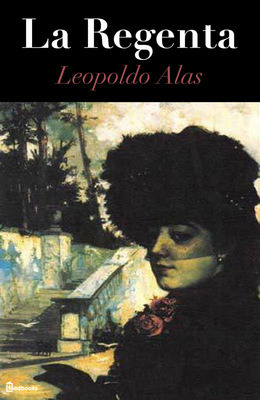"La Regenta,“ or "The Regent’s Wife” in English, is considered to be the masterpiece of Leopoldo “Clarín” Alas, one of the most proficient and well-known Spanish writers of the 19th century.
A tome of 1,000 pages, the novel was originally published in two volumes, and is the Spanish version of novels such as “Madame Bovary,” “Anna Karenina,” and “Nana.”
It follows the life of the regent’s wife, referred to as Ana or simply La Regenta. Raised by a governess after her mother died and her father abandoned her, Ana is forever marked by the cruelty shown to her not only by the governess, but also by her aunts, whose only aim is to fatten her up so as to marry her off.
Basically sold into marriage by her aunts to Víctor Quintanar, Ana finds herself in a lonely situation with no one to bear witness to her sorrow. Her new husband has no interest in sex or a relationship; in fact the only time he touches her throughout the novel is to give her parental kisses.
Ana longs to lead a fulfilling life, and bemoans the fact that she doesn’t have a child. She tries to fill her time with reading, with being a ‘good’ wife, and other hobbies, but all of them leave her miserable. She is soon befriended by the magistral, Don Fermín, who also acts as her confessor. They strike up a fast and intimate friendship, often gossiped about by others in Ana’s social circle.
Not long after she begins her friendship with Fermín, Don Alvaro, the city’s Don Juan character, starts to compete for Ana’s attention and friendship, flirting with her at every opportunity.
Ana struggles to keep both men happy, even though they are competing for control of different parts of her: Fermín her soul and Alvaro her body. They both have something in common though–they both treat her as an object to be conquered instead of a human being with feelings, common enough treatment for women in this time period but still a bit shocking to read over the course of so many pages.
Interestingly enough, early criticism never saw Ana as the protagonist of the novel; they all argued over which male character was the most important: Víctor, Fermín, or Alvaro.
Alas creates his own world in the 1,000 page text, and provides so many details and intricate storylines that not one chapter seems superfluous–every word, every image created, is necessary to our understanding of Vetusta (the fictional version of Oviedo, Spain).
Although I won’t ruin the ending for you, I will say that although “La Regenta” does not end like the contemporaries of the time, it does leave readers with a sense of something unfinished.

"La Regenta" se considera como la obra maestra de Leopoldo “Clarín” Alas, uno de los novelistas españoles más proficientes y conocidos del siglo XIX.
Un tomo de 1,000 páginas, la novela fue publicada en dos volúmenes originalmente, y es la versión española de novelas como “Madame Bovary,” “Anna Karenina,” y “Nana”.
Sigue la vida de la regenta, referida como Ana o simplement la Regenta. Criada por un aya después de la muerte de su madre y el abandono de su padre, Ana está marcada para siempre por la crueldad la mostraron no sólo su aya, sino también sus tías, las quienes único objetivo es engordarla para casarse.
Básicamente vendida en matrimonio por sus tías a Víctor Quintanar, Ana se encuentra en una situación de soledad con nadie para dar testimonio a su melancolía. Su nuevo marido no tiene ningún interés en sexo ni en una relación con ella; de hecho, la única vez que le toca en la novela es para darle besos paternos.
Ana desea llevar una vida gratificante, y se lamenta el hecho de que no tiene un niño. Intenta a llenar su tiempo con leer, con ser una ‘buena’ esposa, y otros pasatiempos, pero todos la dejan miserable. Pronto un magistral, Don Fermín, se hace amigo de ella, y también como su confesor. Entablan una amistad rápida y íntima, la cual es el objeto de mucho chisme en su grupo social.
Poco tiempo después de empezar su amistad con Fermín, Don Alvaro, el Don Juan de la ciudad, comienza de competir para la atención y la amistad de Ana, flirteando con ella con cada oportunidad.
Ana intenta hacer los dos hombres felices, aunque están compitiendo para control de partes diferentes de ella: Fermín su alma y Alvaro su cuerpo. Sin embargo, los dos tienen algo en común–los dos la tratan como un objeto para ser conquistado en vez de un ser humano con sentimientos, tratamiento bastante común en este tiempo pero todavía un poco impactante para leer en el transcurso de tantas páginas.
De modo interesante, la crítica más temprano nunca vio Ana como el protagonista de la novel; todos se discutieron sobre cual personaje masculino fue lo más importante: Víctor, Fermín, o Alvaro.
Alas crea su propio mundo en su obra de 1,000 páginas, y provee tantos detalles y tramas intrincadas que ni sólo un capitulo parece superfluo–cada palabra, cada imagen creado, es necesario para nuestro entendimiento de Vetusta (la versión ficticia de Oviedo, España).
Aunque no voy a arruinar el final para vosotros, diré que aunque “La Regenta” no termina como los contemporáneos del periodo, deja los lectores con un sentido de algo inconcluso.